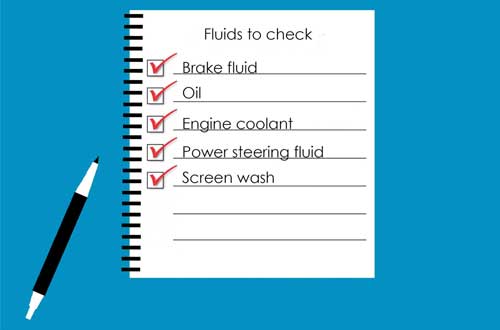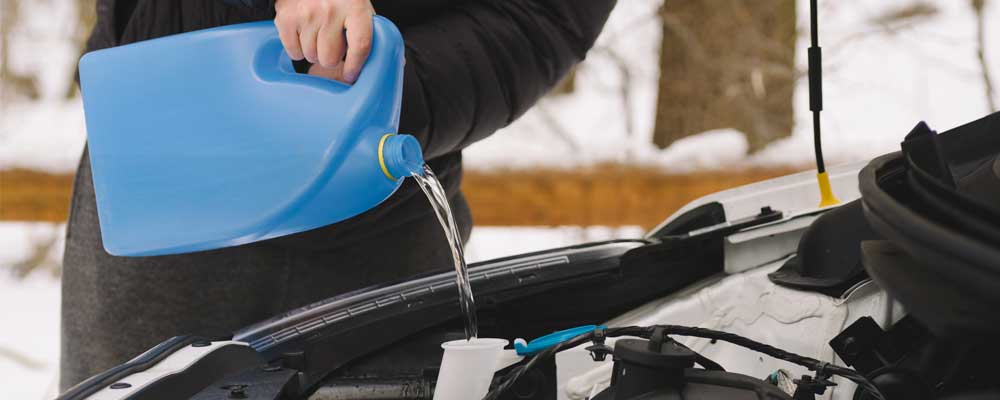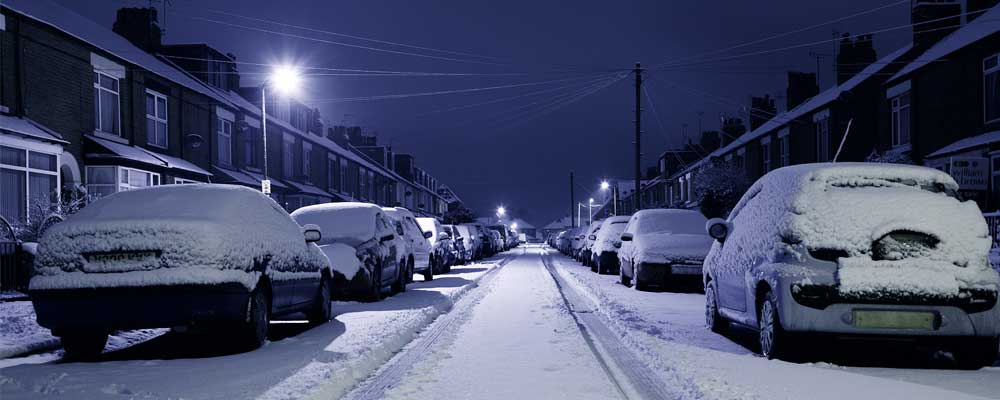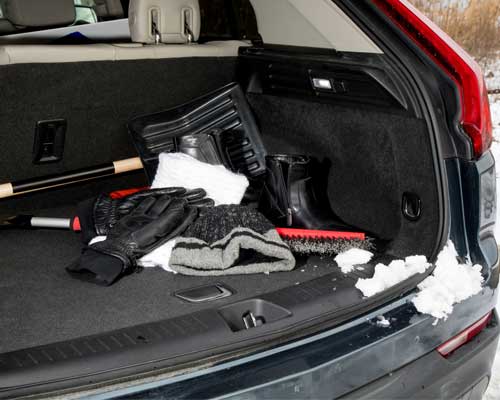- Takes longer to turn over
- Stuttering before engine engaged
- Clicking sound and engine will not turn on
- Red battery warning light flickers when driving
- Red battery warning light remains for longer when starting the engine
- Car lights are dim
- Experiencing electric issues
- Swollen battery case
Taking care of your car is important all year round whether it’s your personal vehicle or one provided to you by your company. Depending on the time of year the steps you need to take to look after your car can vary so we’ve put together this guide to looking after your car during the colder months as well as one for warmer weather.
General Car Care
There’s some tasks and checks you should be doing no matter what the time of year in order to keep the vehicle in a roadworthy condition.
These checks include tyres, vehicle fluids and keeping it clean.
Tyres
It’s important to check your tyres regularly to ensure they are both legal and safe for you to drive on as driving on unsafe tyres will not affect your fuel consumption, passenger comfort, the vehicle’s traction on the road and could potentially cause further incidents if the tyre is damaged.
There are three main checks you will need to make:
- Tyre pressure
- Tyre tread depth
- General tyre condition
Every car has a recommended tyre pressure which is the optimal pressure that it operates at it, which helps with your fuel efficiency, reduces excess wear to other parts of the vehicle and is the safest pressure for the drivers.
We advise checking your tyre pressure regularly to ensure you are within your recommended range, which can be found in the vehicle manual or on some models on the inside of the door. If you regularly do long journeys or clock up a lot of miles then you will want to check the tyres more frequently.
All tyres should have a minimum continuous tread depth of 1.6 mm around the central three quarters of the tyre. If they are lower than this then they will be under the legal limit and you should replace them as quickly as possible.
You can check tyre tread with a 20 pence coin. Simply place the coin in the tread and as long as it covers the outer border of the side that it is inserted with this will be over the depth limit.
Checking the tyre conditions is a visual check that drivers conduct to ensure that there is no damage to them looking for any cuts, cracks or bulges. If you do notice any of these then you should take the car to a garage to be looked at as they may need repairing or replacing.
If you are at all concerned about the condition of any of your tyres then you should take them to be looked at by a professional.
Checking Your Vehicle Fluids
Just like with your tyres you should regularly check your vehicle’s fluid levels to prevent them from getting too low.
The fluids that you should be looking at are:
When you are checking any fluids you should park on level ground to ensure that the angle of the vehicle does not affect the readings that you get.
You will also want to do any checks when the engine is cold. This is not only for accuracy but also for safety as a hot engine or fluids can cause serious injuries.

Checking the Brake Fluid
It’s recommended that the brake fluid is changed regularly, with most manufacturers advising you change it around every two years or so. Between changes though you should check the fluid and top it up if necessary. If you ever feel your brakes being slow or abnormal then the fluid level could be why so you should check it then too.
The brake fluid will be located under your vehicle’s bonnet, as will the rest of the fluids you check, and you should be able to find it easily. If not, there should be an image in the vehicle’s manual that highlights the location or you could ask your mechanic to point it out to you the next time that your car is in the garage.
The first thing you should check is the colour of the fluid, it should be light, nearly transparent and not cloudy or dark. If it is cloudy or dark we advise taking it to a garage to have the fluid changed.
There will also be a minimum and maximum level on the side of the container which it should sit between. If the fluid is below the minimum then you should top it up.
The type of brake fluid needed varies between models so you should always check the type that your car accepts.
Checking the Oil
The next fluid that will regularly need checking is the oil. Oil is essential for the engine to work so it’s important that you do not run low on it as a lack of oil can cause engine failure and major damage.
All cars with a combustion engine will have a dipstick that will have a yellow or orange pull tab. To check the oil level, you will need to remove the dipstick, wipe it clean and then reinsert the dipstick fully. After a few seconds you should pull the stick out and this should provide you with an accurate level for the oil.
There should be minimum and maximum level markers on your dipstick and you will want the oil level to be in between the two.
If you need to top up the oil then near the dipstick you will find the lid to the oil container which you can remove and then top up via the wider container entry.
Again the oil type that your car prefers will vary between model so we recommend checking the vehicle manual or manufacturer website for the correct type.
As well as the oil level you’ll also want to check the condition of the oil. It should be an amber colour and fairly runny, if it has turned a milky colour or thickened at all we recommend the oil is changed rather than just topped up.
Checking the Engine Coolant
A lot of excess energy that a combustion engine produces is converted into heat and to prevent overheating cars will use coolant fluid.
Please note it’s important that engine coolant is not checked when the engine has recently been on, you should wait until the vehicle is fully cooled as the coolant system runs very hot and is highly pressurised so can cause severe burns if opened when warm.
Your coolant tank will have minimum and maximum lines that you will be able to see and the liquid level should sit comfortably between the two.
Checking the Power Steering Fluid
Power steering fluid ensures smooth and effortless steering and so if you find your steering is a little off then we’d recommend checking this fluid first to see whether it’s too low or high.
The location of the power steering fluid varies between cars so might not be under the bonnet, we’d advise checking your vehicle manual to find out where it is.
There will usually be level markings on the side of the container but you will want to check carefully as there are two sets of minimum and maximum levels – one for hot and one for cold. If the car has been used within eight hours then we advise using the hot levels but if it has been longer use the cold ones.
You can then open the cap and top it up if needed, we’d suggest using a funnel to avoid spilling any around the tank.
Checking the Screen Wash
The windscreen washer fluid is the one you will find needs topping up the most often as you will use this the most.
To check the levels you simply need to look at the container and top up if it looks a little low, there are no minimum or maximum levels as it’s not an essential fluid for the vehicle to run or dangerous if overfilled.
Screen wash is an important fluid especially when roads are wet and muddier which can cause more dirt on your windscreens impeding your vision.

Tips to Avoid a Winter Breakdown
1. Check your vehicle regularly, use our detailed car checks listed above to make sure everything is in good running order.
2. Pay particular attention to your battery as they work better in warm weather the winter is when you're most likely to get a flat battery
3. Make sure your wiper blades are in a good condition as they will need replacing around once a year and worn or broken wiper blades can prevent your windscreen from being cleaned properly and lead to your vision of the road ahead being impaired
4. Check the weather forecast before you travel and make sure you and your car are suitably equipped for the weather en-route and at your destination
5. If possible keep your car in the garage in order to minimise its exposure to cold weather and reduce the risk of battery wear, weather damage and much more
Keeping Your Car Clean
We recommend drivers keep their car clean throughout the year for a number of reasons but during the winter it helps to reduce distractions to the driver, minimises the risk of food rubbish attracting animals, and prevents paintwork damage from road dirt and debris.
You can take your car to a drive through carwash or valeting service for it to be cleaned for you or if you want to clean the car yourself you can do so with as little as a bucket, sponge and cleaning shampoo, though you will find it easier with a hose or power washer.
If cleaning at home we have a few tips to help make it easier for you.
- Choose your tools carefully. If you’re using brushes make sure you don’t use a too abrasive one on the paintwork but choose a specialised wheel brush for the alloys to get all the dirt off. You’ll want a microfibre cloth or shammy to dry the vehicle after your final rinse to prevent water spots.
- Before cleaning rinse the car off with clean warm water.
- Follow any instructions on the cleaning product you have chosen.
- When cleaning you might want to get specialised products for the alloys, the glass, fabric or leather seats or your dashboard.
- If using a sponge or brush to clean your vehicle then you want to be careful you don’t scrub against the paintwork too hard to avoid causing damage.
- Don’t be afraid to repeatedly clean one spot, stubborn stains or dried on bird droppings may take a couple of passes before they are fully removed.
- Try to dry the windows so that they aren’t left with any smudges or marks on them.
Once the vehicle is dry then you might want to wax the exterior for additional protection from the elements, especially heading into colder weather.
On the interior you want to try and keep your car as free of rubbish and clutter as possible. This will not only help prevent your nice warm car with food in from attracting animals but also prevents any loose items from flying around if you need to brake suddenly which can cause damage to the vehicle and injury to the passengers.
You also want to ensure that there is no dirt or marks on the glasswork that restricts your vision of the road.
Driving in the Winter
In the colder months, it’s common for ice to build up on the roads and your vehicle overnight and you will need to take a few steps to adjust for this.
Under Rule 229 of the Highway Code you must clear all your windows and mirrors, remove any ice from your lights to ensure you have the best visibility possible and ensure your number plates are visible.
We advise turning the vehicle on and using the demist setting to help melt the ice from underneath. You may then want to use an ice scraper or de-icer spray to speed the process up.
If you are going to manually scrap the ice from the glass then you should use an ice scraper rather than another household object which could damage the window beneath.
Do not use hot water to melt the ice as this can cause the windscreen to crack due to the sudden temperature change.
Some drivers find it more convenient to put an insulated, waterproof cover over the windscreen to prevent ice from building up on the glass and just remove this instead of having to deice.
Although we might not get much snowfall in the UK it’s still important that you know the essentials for driving in it.
Before you set off you should clear the windows and mirrors as you would with ice and additionally clear any snow on the roof as this may cause a hazard for you or other road users if it falls while moving. You could also be charged with driving without due consideration or using a motor vehicle in dangerous conditions if you are found driving with snow on top of the vehicle which restricts your vision or causes a hazard for other road users.
When driving in snow you should be careful and drive more cautiously and at lower speeds than you usually would so that you have more time to react if you encounter a hazard. Snow can also hide ice underneath it which is an additional hazard for drivers to be aware of.

Preparing a Winter Emergency Car Kit
We think that keeping a breakdown kit in your vehicle in case you're involved in an accident or your car breaks down is sensible no matter what the time of year is but there are some extra items you will need in winter.
The specific items will vary between drivers but in general you will want to include the below in your winter breakdown pack.
- A warning triangle
- A high-vis jacket or vest
- A first aid kit
- A bottle of water
- Cereal bars or similar long lasting snacks
- A torch
- A shovel
- Walking boots
- A spare coat
- Hat, scarf and gloves
- An ice scraper and de-icer

You can then add anything else that is essential for your own needs and tastes. For example, some drivers choose to add a blanket for warmth, those with children often keep something entertaining for them in the car or you might swap the cereal bars for your preferred non-refrigerated snack.
In a lot of European countries items like a warning triangle and high-vis are a legal requirement for all vehicles but the UK does not currently have any laws on them.
Look After Your Battery
Batteries work best in hot weather as they are able to conduct electricity more easily in warmer weather. This means that in the colder winter months they find it harder to conduct electricity and you’ll find that your car might need a jump start or go totally flat more often in winter months.
To avoid this we advise running the vehicle for at least half an hour twice a week to help keep the battery charged, even if you do not need to drive anywhere.
Signs Your Battery's Dying
Another thing to bear in mind is that batteries do have a shelf life and car batteries will usually only last four to five years.
Animals
In the winter you should also keep an eye out for animals around your parked vehicle. Small mammals like cats, hedgehogs and mice are attracted to the warmth of a recently used engine and the shelter the vehicle can provide during rainy and windy weather.
What to Do When Driving in the Snow
When setting off you might find it easier to use second gear to help reduce the risk of your wheels slipping, or if your car has a winter mode then this will have the same effect.
You should drive at lower speeds and give vehicles ahead of you much more room in order to allow yourself plenty of time to react to any hazards such as hidden ice beneath the snow, an unexpected vehicle movement ahead or even just an unexpected turn.
While driving in the snow you should accelerate gently using low revs and change up to a higher gear sooner than you usually would in order to keep them low. When you are going downhill you'll want to transition into a lower gear to help keep your speed low.
What to Do When Driving in Fog
When driving in any poor weather conditions, which includes fog, you want to slow down and increase the braking distance between you and the vehicle ahead in order to give yourself more reaction time.
With reduced visibility, you'll want to put on your low beam headlights, don't use the high beams as this can actually reduce visibility due to the way they reflect on the fog. Additionally, once the visibility is below 100 metres then you should put on your fog light in order to make you more visible and visible earlier on to other road users.
If you reach a point where you are struggling to see and feel unsafe due to reduced visibility then it's better to pull off the road at a safe location where you will not be a potential hazard for other road users and wait for the fog to pass.
What to Do When Driving in the Rain
Here in the UK we get a lot of rain all year round but when it's a particularly heavy downpour there will be some adjustments you need to make sure you're safe.
Firstly you should adjust your speed and travel a little slower and leave a larger gap between you and the vehicle in front of you, not only will this give you more time to react but a wet road can need extra time for slowing down. If you aquaplane, skid on water, you should come off the accelerator but not brake instead allow the removal of your foot from the accelerator to slow you down and try to control the vehicle steer.
If visibility is reduced due to dark clouds and strong rainfall then you should put your headlights on low beams.
As rain is cold you might experience condensation build up on the inside of the vehicle due to the two differing temperatures (inside and outside of the car) meeting at this point, in order to prevent this turn your air conditioning / heating system on. You can use the windscreen setting or just having it on and air moving throughout the cabin will usually be enough to reduce condensation buildup if not prevent it.
For more guides on looking after your car and much more head back to our driver section.
